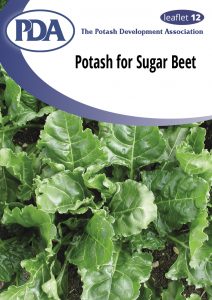Download pdf: Potash and sugar beet (3.10M)
pdf 3.10M
Potash and sugar beet
March 2022
During the last four decades, yields of clean beet and sugar in the UK have been increasing linearly, at an average annual rate of 0.8 t/ha of clean beet. The five-year average yield has increased from approximately 45 t/ha in the early 1980s up to 80 t/ha more recently.
This rapid increase in yield raises the question of whether the currently recommended amounts of potash are adequate to achieve this target, especially as the recommendations are largely based on results of experiments that are 40-50 years old. In the revised sugar beet leaflet, data from more recent experiments has been used, in which yields exceeding 70 t/ha adjusted beet were obtained, to re-examine the recommendations for potash.
Role of Potassium
Potassium has several roles in plants. It is essential for the activation of some enzymes within the cell. Only a small proportion of the total K in plants is required for this, but in these roles it cannot be replaced by any other element. Much more K is required to fulfil other major functions in plants.
In these roles the plant prefers to use K rather than other elements (like sodium and calcium), therefore the plant must have a sufficient supply of K available to it because it will take up large quantities of K daily from the soil during growth.
Potassium is essential for growth and is the main element used to maintain cell turgor (rigidity) and to regulate the water content of the plant. Potassium is also involved in controlling the opening and closing of the stomata (the openings in leaves through which water is lost by transpiration and carbon dioxide enters the leaf to be converted to plant dry matter and sugar).
The importance of cell turgor cannot be over-emphasised. For maximum sugar yield it is essential to optimise the interception of solar radiation (sunlight) to provide the energy for the conversion of carbon dioxide to sugars. This requires a rapidly expanding leaf canopy. Nitrogen (N) supply drives the rapid production and expansion of cells.
The last newsletter focussed on the reduction in yield response to applied fertiliser nitrogen when the exchangeable K content of a soil is below a critical target level. This response by a crop to one nutrient being dependent on an adequate supply of another nutrient is known as an interaction between the two nutrients. Where such interactions occur there is no point in saving on one fertiliser input if this affects an important aspect of crop growth which limits the effect of another fertiliser input.
Applying nitrogen to meet increasing demand by a rapidly growing crop invariably results in an obvious visual response, which is invariably associated with an increase in yield. This association between N supply and yield is observed so frequently and the increase in dry matter is expected as a matter of course. What is less obvious and rarely realised, however, is that the increased supply of N also greatly increases the amount of water in the crop.
These differences in the water content are much greater in sugar beet than other crops, such as cereals. Sugar beet plants well supplied with N can contain 30-35 t/ha more water than those with less N. These increases in water content come about through the stimulation of cell division and cell expansion and lead to an increased demand for larger amounts of osmotic solutes such as potassium to maintain turgor. Thus, applying more N to increase yield requires more plant-available K in the soil and without this K, the response to N will be limited.
Potassium also has another equally important role in the transfer of sugars produced in the leaves to the storage root. In its passage from leaf to storage root each molecule of sugar must pass through innumerable cell membranes, and K+ ions are an essential component of the ‘molecular pump’ within the cell membranes that facilitate this passage.
Potassium uptake
Chart 3 shows the total crop uptake of K in the harvested beet. Where maximum yields were achieved at soil K Index 2- (i.e. 120-180 mg K/litre) the corresponding uptake into the crop was up to 480 kg K2O/ha of which 90-100 kg K2O/ha was in the harvested beet and therefore removed from the field. On soils with plentiful K, the uptakes and offtakes of K can be much larger than this optimal requirement (i.e. up to 600 kg K2O/ha in the crop and 150 kg K2O/ha removed, respectively). Extra K in the roots, however, does not increase clean beet or sugar yields; it serves only to decrease beet quality.
Potassium offtake (removal from the field)
Much of the K needed by the crop is taken up during the early months of growth (Chart 4). However, more than 70% of it remains in the tops at harvest, and will be returned to the soil if the tops are subsequently ploughed in. Although the amount of K removed in harvested beet is considerably less than in the tops (90-100 kg K2O/ha), it still must be replaced to maintain the soil at an appropriate K Index.
Role of sulphur
In sugar beet, as in all crops, sulphur is essential for protein synthesis. The uptake of sulphur by sugar beet is around 50-70 kg SO3/ha in average yielding beet crops and as much as 100 kg/ha in higher yielding crops. An imbalance of nitrogen and sulphur, caused by sulphur deficiency can result in amino nitrogen accumulation within the plant, leading to lower quality and reduced root storage capacity.
Work on other arable crops such as OSR and cereals has shown that crops frequently respond to additional sulphur fertilisers, especially on lighter land where the risk of sulphur deficiency is greatest. The depletion of atmospheric deposition of sulphur is well documented. Previous trials have identified small but often inconsistent response of sugar beet to additional soil-applied sulphur.
BBRO’s conclusion for the trials so far suggest that 40-60 kg SO3/ha is sufficient for sugar beet crops, using the higher rate where yields are expected to be >80 t/ha.
Summary
- Potassium (K, potash: K2O) is essential for all crops and sugar beet requires large amounts.
- Soils should be maintained above the critical level for plant-available K, P and Mg to achieve optimum yields and quality of all the crops grown on the farm.
- For sugar beet, the critical level for potash is K Index 2-. Below this level, yield will be lost. Yields are not increased when soils are at K Index 3 and above.
- Crops need K where the roots can get it, i.e. throughout the soil explored by the roots. Sugar beet only very occasionally responds to freshly applied potash, and then only on soils with very low levels of available K (K Index 0). It is wise to regard applications of potash as part of the longer-term strategy to raise or maintain soil K at a suitable level rather than as a means of immediately increasing beet yields or correcting deficiency.
- Potassium in the ploughed-in tops is returned to the soil K reserve.
- To maintain adequate levels of soil K, the K removed in the harvested beet needs to be replaced on all soils below K Index 3. The quantity removed can be seen for individual contracts from British Sugar On-line.
- Sugar beet has a sodium (Na) requirement and in addition, sodium can substitute for some of the functions of potash; applying Na will be of benefit on K Index 0 and 1 soils and on soils low in available sodium.
- The uptake of sulphur by sugar beet is around 50-70 kg SO3/ha in average yielding beet crops and as much as 100kg/ha in higher yielding crops.
REMEMBER: Once soil K has been adjusted to above the critical level it needs to be maintained at that level because at lower levels yield loss cannot be corrected immediately by fresh potash. This maintenance can be achieved by estimating the amount likely to be removed in the harvested beet before the sugar beet is sown or replacing the amount removed before the next crop is sown. Either way, the actual K status of the soil needs to be checked by soil sampling and analysis every 4-5 years.


